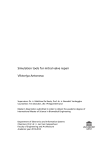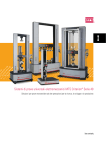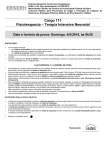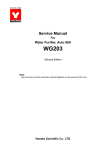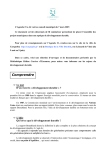Download TROUBLESHOOTING GUIDE
Transcript
TROUBLESHOOTING GUIDE INOUE - BALLOON This guide is intended as a troubleshooting guide only, to cover some of the more common problems associated with the Inoue Balloon Catheter and advise on how to prevent/solve them. (Not all procedures and cautions are covered within this document. Please read the “Instructions for use” accompanying the device before handling the product). 1. KINKING OF THE BALLOON & TWISTING OF THE INNER TUBE A) KINKING OF THE BALLOON Kinking occurs due to the Inner Tube bending and can often be identified by: a. An Acute angle b. A Zigzag – The Balloon expanding at the distal tip (difficult to notice externally) Causes of Kinking: a. When only the inner tube is advanced into the catheter. incorrect Without the balloon stretching tube. incorrect Without the balloon stretching tube connected to the gold hub. b. When the balloon stretching tube is disconnected from the inner tube while both the balloon is stretched and the Guidewire is not fully inserted. correct c. When both the balloon stretching tube and the Guidewire are removed from the inner tube in a situation where both the balloon is stretched, and the inner tube is not properly pulled out from the W-connector. incorrect incorrect Solutions to Kinking: Follow steps 1-6 Step 1. Unlock the inner tube from the W-connector and pull it out until resistance is felt (do not attempt to reconnect the hub of the balloon stretching tube to the inner tube while the inner tube is still locked into the W-connector). Step 2. Inflate the balloon completely, then deflate immediately. Step 3. Insert the Guidewire.* Step 4. Insert the Balloon Stretching Tube* into the inner tube and secure the hubs with the lure lock. Step 5. Advance the inner tube (with the balloon stretching tube locked) into the W-connector. Place the pin of the inner tube into the slot on the W-connector and secure the lock. This way the balloon will be stretched normally. Step 6. Withdraw the catheter from the patient and discard it. Use a new Inoue Balloon Catheter. * If the Guidewire or balloon stretching tube cannot be inserted correctly into the inner tube following the above procedure, the balloon cannot be stretched and this may result in difficulty when removing the kinked balloon through the interatrial septum and/or the femoral vein puncture site. In this case the kinked balloon should be carefully removed using the best clinical judgement. B) TWISTING OF THE INNER TUBE Twisting of the inner tube lumen occurs when there is a rotation of the inner tube at its attachment to the W-connector end of the Inoue Balloon. It is very important to hold the W-connector and not the inner tube during catheter manipulation, this will avoid inner tube twisting. It is equally important to hold the W-connector and not the inner tube during manipulation of the stylet to direct the balloon. correct incorrect CAUTION: Separation of the Guidewire or Stylet If balloon kinking or twisting of the inner tube should occur, there is a possibility that the Guidewire may get stuck in the Inoue Balloon Catheter and the balloon cannot be stretched. Never insert/advance the balloon stretching tube under these conditions. If the balloon stretching tube is inserted under these conditions, this too, may become stuck. In the event of a balloon kink or twisted tube there is also a possibility the Stylet may become stuck. Withdrawing the Guidewire or Stylet by force may cause damage to the tip of the Guidewire or Stylet, leading to the possibility of separation of the tip. incorrect 2. Abnormal Balloon Inflation Abnormal or unusual balloon inflation is caused by a mesh breakage. The Balloon is composed of three layers. There is an outer latex layer, an intermediate mesh layer, and an inner latex layer. The mesh regulates maximum diameter and inner pressure of the balloon. Mesh breakage may be caused by: a. Over-inflation of the balloon, past the acceptable inner balloon pressure. b. Rapid increase of inner pressure that may occur when the balloon is inflating in a heavily calcified mitral valve. When performing test balloon inflation and air purging prior to Percutaneous Transvenous Mitral Commissurotomy (PTMC) take note of the following: a. Do not exceed the maximum recommended inflation volume marked on the syringe provided with the Inoue Balloon Catheter. correct incorrect b. Inject dilute contrast medium slowly to inflate the balloon during the test inflations in order to avoid rapid stretching of the mesh layer. Exporter: Representatives: Toray Medical Co., Ltd. Toray Europe Ltd. ARCA Central 21F., 2-1, Kinshi 1-chome, Sumida-ku, Tokyo 130-0013, Japan 3rd Floor, 7 Old Park Lane, London W1K 1AD, England, U.K. Manufacturer: Toray Marketing & Sales (America), Inc 012 3 Toray Industries, Inc. 140 Cypress Station Drive, Suite 210 Houston. TX 77090, U.S.A 2-1, Nihonbashi-Muromachi 2-chome, Chuo-ku, Tokyo 103-8666, Japan Toray Industries (Singapore) Pte. Ltd. 31 Exeter Road, #31-01 Comcentre, Singapore 239732, Republic of Singapore 01 05 OB Printed in Japan


